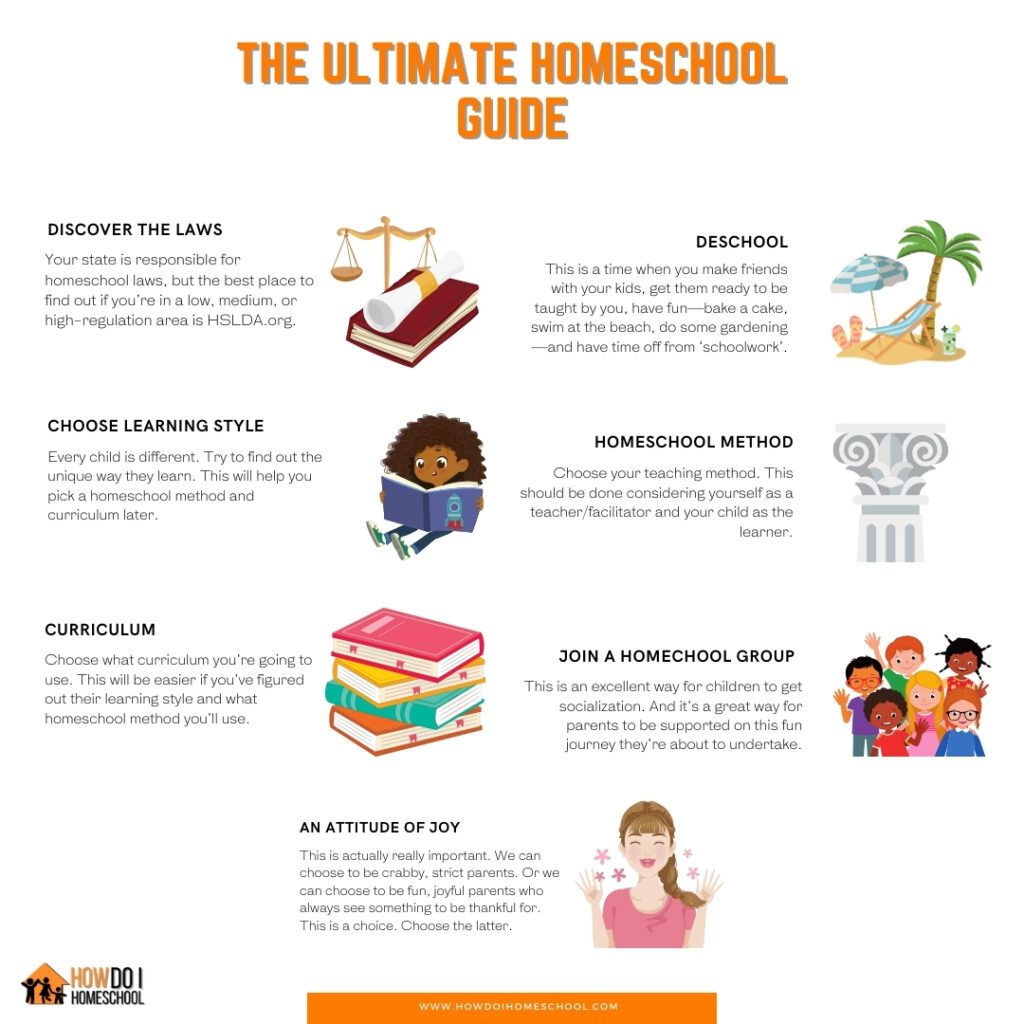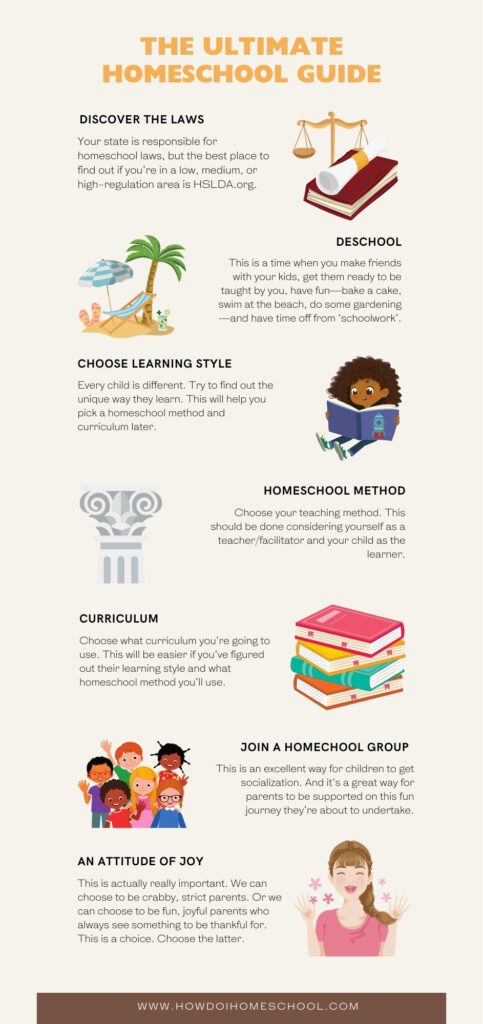Whether you’re just dabbling with the idea of homeschooling or you’ve decided it’s for you and you’re ready to take the first steps, you’re probably asking yourself, ‘How do I homeschool?’

I hope you enjoy reading this blog post. If you want to do my course on how to homeschool, click here.
Below, we’ll cover several steps that will help you get started with home education.
In addition, we’ll look at useful resources so you can start homeschooling your child tomorrow.
Below, we’ll consider the basics of how to homeschool:
- Finding your state’s homeschooling laws
- Deschooling
- Looking into a homeschooling method that suits you
- Picking a suitable curriculum
- Deciding if you need a schedule
- Finding homeschooling groups in your area
- Setting up a homeschooling room
- Being patient and ready to adapt
These topics will answer your most basic questions about how to homeschool, but if you want to give your children a great education, it’s useful to educate yourself by:
- reading home education blogs and
- attending homeschooling conventions
These will help you keep improving your educational approach.
Affiliate links used in this post.
Don’t forget that parents will probably be doing as much learning as their children in their first year of homeschooling!
But let’s get started and look at relevant laws for your homeschool.
Finding Your Homeschool Laws
The federal government doesn’t regulate home education but by individual states.
It’s important to track down your state’s homeschooling laws, as these could significantly impact the type of curriculum and homeschooling method you choose.
Some states like Texas and Missouri are very relaxed with their laws and don’t require parents to register.
Other states like New York and Pennsylvania are strict and require registration, adherence to a syllabus, and regular testing to check up on the curriculum you’re teaching.
You can find these home education laws by visiting your state’s Department of Education website or by checking homeschooling laws with the HSLDA.
HSLDA.org provides parents with an easy-to-read overview.
It also provides them with a quick-view map that shows the level of regulation in their state using green, orange, and red indications.
It’s also important to find out if you need to formally withdraw your child from the school district in your area.
This is important as you may accidentally be investigated for educational neglect by a truancy officer if you forget.
Sound dishearteningly difficult?
It’s not as difficult as it might sound and getting a homeschooling mentor from an experienced homeschooling parent in the social group you join will reduce anxiety and assist you in figuring out the legalities more.
(More on social groups further down the page.)
Deschooling (DO NOT SKIP)
Deschooling is a process whereby children and parents are deinstitutionalized from the institutionalized mindset that comes from school.
The process involves giving children and parents a good time period with no schoolwork.
They can now adjust because they’re no longer involved with a school institution.
This gives parents time to consider:
- what educational method they’d like (instead of having to accept the one the school uses),
- the way their child learns best,
- the things that motivate their child best,
- any learning needs that can be catered for in a home situation, and more.
Best of all, it gives the family time to relax together.
And make friends.
This is super-important before the family starts homeschooling because your child won’t want to learn from you if you’re not friends.
Deschooling effectively involves having a good time together, such as going to the beach or cooking at home.
The purpose of deschooling is that you’re all relaxed and focused on your new learning pathway.
You now all have an idea of how to homeschool…what you want your homeschool to look like.
This can be a good time to set overarching goals for your family’s educational journey.
Watch the video below to learn about deschooling, a vital element when starting homeschooling.
Find a Homeschool Method
Before choosing a curriculum, consider what educational style (that is, the approach or way of homeschooling) you prefer.
By doing this, you can avoid a method that doesn’t suit your family.
You can do this while you’re deschooling.
But how do you decide on a method that will suit your family?
It’s good to observe your children and how they learn.
Consider their interests and learning preferences and note their strengths and weaknesses.
You can do this by seeing how they learn with library books for a while.
Many parents start with a traditional approach (which is akin to the school-at-home method).
After a while, some decide on something that better suits their home environment.
The common homeschooling methods employed today include the following:
- Charlotte Mason method
- Classical method
- Montessori approach
- Unschooling style
- Traditional method
- Unit Studies
- and Eclectic Approach
You can investigate these by following the above links.
Don’t be afraid to alter your method if it’s no longer working for you or your family.
Many people find that what worked in the past is now no longer working for them.
By changing your method, you might discover something you love and your kids are passionate about!
 Picking a Curriculum
Picking a Curriculum
Although there are many curricula, if you’ve decided on a homeschooling method, choosing a homeschooling curriculum will be simpler.
For example, if you’ve chosen the:
- Charlotte Mason method, you can look at some CM curricula here.
- Classical method: you can look at some classical curricula here
- Traditional method: look at traditional programs here.
Also, if you’re a Christian like me, it’s important to pick a good Christian curriculum with great Bible teaching—I love BJU Press.
Many program creators come from Christian backgrounds, so we’re blessed that many curricula are Bible-based.
However, it’s important to investigate this aspect thoroughly, as a few curricula dubiously claim to be Christian.
Of course, if you find the thought of home education difficult because you’re grappling with the costs involved, check out these free curriculum options here.
Tips on Buying a Homeschool Curriculum
Remember that curriculum providers often offer parents the option to trial a curriculum for free.
That way, they can decide if it is right for them before investing in a year’s worth of curriculum.
If you can’t see this option on their website, email them or ask them.
Sometimes, they’re willing to give you a discount or set you up with a free trial just because you asked.
Beware about jumping in too soon and buying an expensive curriculum that doesn’t suit your family.
This is a common story among new home educators, who often feel buyer’s remorse after discovering it doesn’t work for their families.
Finally, remember curriculum goes on sale around July/Aug/Sept.
This corresponds with the beginning of the school year in America.

Schedule/Routine
Although some home learners (like unschoolers) don’t have a schedule they follow, most parents who follow a curriculum want one.
Having a flexible schedule helps them order their day and define their goals.
Once you’ve decided on your curriculum, you can start writing a schedule and planning your routine (or use the one provided with the program).
Include time slots for sports, meal times, free periods, field trips, library visits, and other outings.
Some curricula come with a schedule attached to them (like a lot of the CM or classical curricula mentioned above).
So you just have to think about your daily routine (a routine includes the schedule and your daily activities such as sports or regular social events).
You can see an example of a homeschooling schedule here.
You can also see an example of a homeschooling routine here.
Many free printable homeschooling planners are available online, so you can start your own today.
Of course, the beauty of home education is that you’re not tied to a schedule or routine like school families.
You can be flexible with your days, and you can make up homeschooling hours when it suits you.
Your schedule can change to suit your family – what a quaint idea!
Finding homeschooling groups in your area
Once you’ve sorted out the homeschooling laws, educational method, and curriculum, it’s time to decide how you’ll handle socialization.
Although many home educators realize the importance of this subject, some don’t consider social interactions necessary for their children.
This lack of understanding can lead to significant problems in their homeschool and bitterness towards parents when children grow up.
Homeschooling groups:
- provide children with a social outlet and
- offer new homeschooling parents an opportunity to be mentored by older, more experienced home educators.
Happily, there are many ways homeschoolers can make friends.
Some of the most common places children find friends are in:
- church,
- homeschool co-ops, and
- friendly meet-ups between home-educating families for this purpose.
If you’re new to the area, a good place to start is to check out local homeschooling groups on Facebook (if you have an account) or other websites that list homeschooling groups.
Check out these links for:
Don’t forget to include your immediate family in your child’s socialization.
Get grandparents to take children on educational outings or to sports lessons.
Let them attend grandma’s weekly art classes with her.
Your child will delight the room with their energy and youthful innocence.
I take my little ones to the local nursing home, and we visit an 89-year-old lady who ‘doesn’t get many visitors’.
She assures us it is the highlight of her week!

Setting Up a Homeschool Room
Although most people think about curriculum first when deciding how to homeschool, some consider their physical surroundings more and question whether they can fit a homeschooling room into their house or apartment.
If they can, what should go into it?
The answer to this question depends on the educational method you’ve chosen.
If you’ve chosen the Montessori method, for example, the type of room you setup will be vitally important as it’s a big part of that method’s educational philosophy.
(You can see an example of a Montessori house setup here).
Some great basic ideas include getting storage cabinets, modular bookshelves to hold books, or sliding boxes for homeschooling supplies.
Baskets and hooks also keep different items organized neatly around the home.
Most families can get away with a fairly simple setup and don’t need extraordinary extras.
However, if you love home decorating, you can go to town and set up some cute rooms.
Check out this link here for some extensive homeschooling room ideas.
Be Flexible and Patient
Learning the ins and outs of how to homeschool is not a process that can be completed overnight.
Sometimes it takes a long time to fine-tune.
It’s important to remember that patience is an advantage when trialing homeschooling methods, curricula, and even social groups!
But if you commit for a decent time period, things will get easier as you figure out what works best for your family.
It may take as long as a year to organize your family’s learning lifestyle, but eventually, you should have a great one!
Remember, it’s normal to question yourself repeatedly when you begin home educating.
Almost nobody starts homeschooling by hitting the ground running.
To help you on your journey, find a friend who is new to homeschooling and support each other on this journey.
Also, find an experienced home educator who can mentor you and help you through the tough times.
Don’t be discouraged if your kids didn’t seem to learn much that day. They probably understood more than you knew. In any case, tomorrow is a fresh start!
 Conclusion
Conclusion
Learning to homeschool can take a while, so be patient and relax for the journey of a lifetime! When things seem overwhelming, think about the great times you’re about to have with your children and the reasons you began this journey in the first place. Above all, remember that home education is a proven way of training your children, and as a parent, you’re intrinsically qualified to give them a good and loving education!

 Picking a Curriculum
Picking a Curriculum Conclusion
Conclusion

